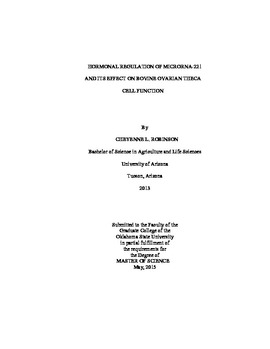| dc.contributor.advisor | Spicer, Leon J. | |
| dc.contributor.author | Robinson, Cheyenne L. | |
| dc.date.accessioned | 2016-09-29T18:36:46Z | |
| dc.date.available | 2016-09-29T18:36:46Z | |
| dc.date.issued | 2015-05-01 | |
| dc.identifier.uri | https://hdl.handle.net/11244/45205 | |
| dc.description.abstract | Development of ovarian follicles in cattle is controlled by systemic and locally produced hormones acting at the molecular level controlling numerous gene transcripts which spatial-temporal expression leads to one follicle ovulating and other follicles undergoing regression. MicroRNA-221 (miRNA-221) is increased in granulosa and theca cells of subordinate follicles compared with dominant follicles on day 3 of the estrous cycle in cattle. The objectives of this study were to investigate the hormonal regulation of miRNA-221 expression in theca cells and its possible role in regulating follicular function. Bovine ovaries were collected from a local abattoir and theca cells were obtained from large (8 to 22 mm) follicles, cultured for 2 to 7 days in 10% fetal calf serum (FCS), and treated with various hormones in serum-free medium for an additional 24 or 48 h in five experiments. Medium was collected for analysis of progesterone and androstenedione concentrations via radioimmunoassay, or cellular RNA was collected for gene expression analysis of miRNA-221 via real-time PCR. In Exp. 1, FGF9 increased (P = 0.08) abundance of miRNA-221 2.0-fold after 12 h and 2.4-fold after 24 h compared with controls. In Exp. 2, forskolin and dibutyryl cyclic adenosine monophosphate (dbcAMP) had no effect (P > 0.10) on miRNA-221 expression in bovine theca cells, but FGF9 treatments increased (P < 0.05) miRNA-221 abundance 1.94-fold. In Exp. 3, IGF1 had no effect (P > 0.10) on basal or FGF9- induced miRNA-221 expression (3.3-fold increase) in bovine theca cells, however, 10% FCS increased (P < 0.05) miRNA-221 abundance by 3-fold greater than control cultures; the combined treatment of FGF9 and 10% FCS did not differ (P > 0.10) from either treatment alone. In Exp. 4, estradiol, androstenedione, and phytoestrogens had no effect (P > 0.10) on miRNA-221 abundance. In Exp. 5, neither miRNA-221 mimic nor inhibitor affected cell numbers; nonetheless FGF9 stimulated an increase in cell proliferation (P < 0.01). Similarly, neither miRNA-221 mimic nor inhibitor affected steroidogenesis whereas FGF9 inhibited (P < 0.01) IGF1-induced production of androstenedione and progesterone. In summary, exposure of bovine theca cells to FGF9 in vitro increased expression of miRNA-221, however miRNA-221 was not regulated by steroids or cAMP. The role of miRNA-221 in follicular function will require further study. | |
| dc.format | application/pdf | |
| dc.language | en_US | |
| dc.rights | Copyright is held by the author who has granted the Oklahoma State University Library the non-exclusive right to share this material in its institutional repository. Contact Digital Library Services at lib-dls@okstate.edu or 405-744-9161 for the permission policy on the use, reproduction or distribution of this material. | |
| dc.title | Hormonal Regulation of Microrna-221 and Its Effect on Bovine Ovarian Theca Cell Function | |
| dc.type | text | |
| dc.contributor.committeeMember | Hernandez Gifford, Jennifer | |
| dc.contributor.committeeMember | Wettemann, Robert Paul | |
| osu.filename | Robinson_okstate_0664M_14012.pdf | |
| osu.accesstype | Open Access | |
| dc.description.department | Animal Science | |
| dc.type.genre | Thesis | |
